

 |
 |
 |
Mount of Olives
Israel, Jerusalem, 3 March 2009
Overview
On 3 March 2009, Carol and John visited Jerusalem and the Mt. of Olives. We were part of a Grand Circle Tours group that visited, Israel, Egypt and Jordan.
The following photos were taken during that visit with a Canon G.10 “PowerShot” 14.7 megapixel camera. Behind the majority of the thumbnail photos shown below is a full-size (4,416 × 2,480 pixel) 16:9 HD formatted photo. A few of the photos had been straightened and cropped. Although copyrighted © by Skytamer Images, none of the photos contain messy copyright notices. They all look like they came straight out of your camera … Enjoy! These photos are for your personal use only, and are not to be used for commercial purposes without written permission from Skytamer Images.
Let's start off our visit by clicking on the following Google Earth image of the Mount of Olives and the surrounding area. This will help orientate you as to the locations of the various venues that we will be visiting.

Mount of Olives
The “Mount of Olives” (Mount Olivet) is a mountain ridge in east Jerusalem with three peaks running from north to south. The highest, at-Tur, rises to 818 meters (2,683 ft). It is named for the olive groves that once covered its slopes. The Mount of Olives is associated with Jewish and Christian traditions.



Religious Significance
The Mount of Olives is first mentioned in connection with David's flight from Absalom (II Samuel 15:30): “And David went up by the ascent of the Mount of Olives, and wept as he went up.” The ascent was probably east of the City of David, near the village of Silwan. The sacred character of the mount is alluded to in Ezekiel (11:23): “And the glory of the Lord went up from the midst of the city, and stood upon the mountain which is on the east side of the city.” Solomon built altars to the gods of his wives on the southern peak (I Kings 11:7-8). During the reign of King Josiah, the mount was called the Mount of Corruption (II Kings 23:13).
The New Testament, tells how Jesus and his friends sang together — “When they had sung the hymn, they went out to the Mount of Olives” Gospel of Matthew 26:30. Jesus ascended to heaven from the Mount of Olives as recorded in the book of Acts 1:9-12. It will be the Mount of Olives to which he is to return as stated in the book of Acts 1:11 and Zechariah 14:4.
Jewish Customs
The religious ceremony marking the start of a new month was held on the Mount of Olives in the days of the Second Temple. After the destruction of the Temple, Jews celebrated the festival of Sukkot on the Mount of Olives. They made pilgrimages to the Mount of Olives because it was 80 meters higher than the Temple Mount and offered a panoramic view of the Temple site. It became a traditional place for lamenting the Temple's destruction, especially on Tisha B'Av. In 1481, an Italian Jewish pilgrim, Rabbi Meshulam Da Volterra, wrote: “And all the community of Jews, every year, goes up to Mount Zion on the day of Tisha Be-'Av to fast and mourn, and from there they move down along Yoshafat Valley and up to Mount of Olives. From there they see the whole Temple (the Temple Mount) and there they weep and lament the destruction of this House.”
New Testament References
The Mount of Olives is frequently mentioned in the New Testament (Matthew 21:1;26:30, etc.) as the route from Jerusalem to Bethany and the place where Jesus stood when he wept over Jerusalem. Jesus is said to have spent time on the mount, teaching and prophesying to his disciples (Matthew 24-25), including the Olivet discourse, returning after each day to rest (Luke 21:37), and also coming there on the night of his betrayal (Matthew 26:39). At the foot of the Mount of Olives lies the Garden of Gethsemane.
Jewish Cemetery
From biblical times until today, Jews have been buried on the Mount of Olives. There are an estimated 150,000 graves on the Mount, including tombs traditionally associated with Zechariah and Avshalom (Absalom). Rabbi Chaim ibn Attar, author of Ohr Hachaim Hakadosh, is also buried there. Important rabbis from the 15th to the 20th centuries are buried there, among them Abraham Isaac Kook, the first Ashkenazi Chief Rabbi of Israel, and his son Zvi Yehuda Kook. Israeli prime minister Menachem Begin asked to be buried on the Mount of Olives rather than Mount Herzl near the grave of Etzel member Meir Feinstein.
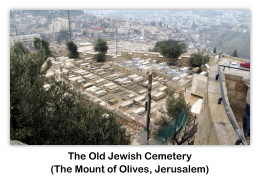

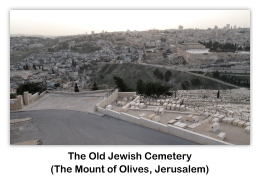
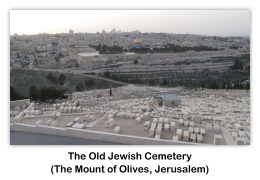




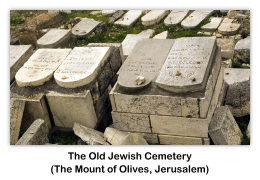
Roman Era
Roman soldiers from the 10th Legion camped on the Mount during the Siege of Jerusalem in the year 70 CE, which led to the destruction of the city.
Jordanian Rule
King Hussein permitted the construction of the Intercontinental Hotel at the summit of the Mount of Olives together with a road that cut through the cemetery which destroyed hundreds of Jewish graves, some from the First Temple Period. Some fifty thousand Jewish graves out of a total seventy thousand were allegedly destroyed or defaced during the nineteen years of Jordanian rule, although this is disputed by many authorities. After the Six-Day War, restoration work began, and the cemetery was re-opened for burials.
Panorama View
When visiting Jerusalem, a trip up the Mount of Olives to the Visitor's Overlook is a must. This panoramic overview from the Mount of Olives, overlooks Jerusalem — new city and the Temple Mount Esplanade of the old city.
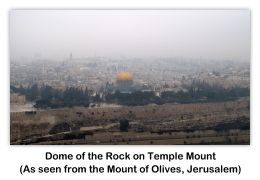
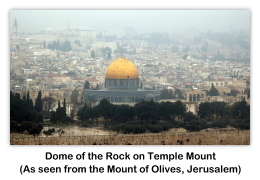
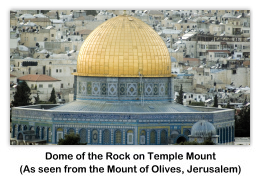





Today
The Arab neighborhood of at-Tur is located on the mountain's summit. Landmarks on the Mount of Olives include Yad Avshalom, the Tomb of Zechariah, the Church of all Nations, the Church of Maria Magdalene, Dominus Flevit Church, Gethsemane, Mary's Tomb, the Mount of Olives Hotel and the Seven Arches Hotel.
This concludes our visit to the Mount of Olives located in Jerusalem, Israel. We hope you enjoyed it. To learn more about the Mount of Olives, visit the Wikipedia site referenced below. Please remember that the photos used on this webpage are copyrighted © by Skytamer Images, and are for your personal use only. Commercial use of these images requires written permission from Skytamer Images.
References
- Shupek, John, “Skytamer Images Photo Archive”
- Google Earth, “Satellite Image”
- Wikipedia, Mount of Olives
Copyright © 1998-2019 (Our 21st Year) Skytamer Images, Whittier, California
All rights reserved


























